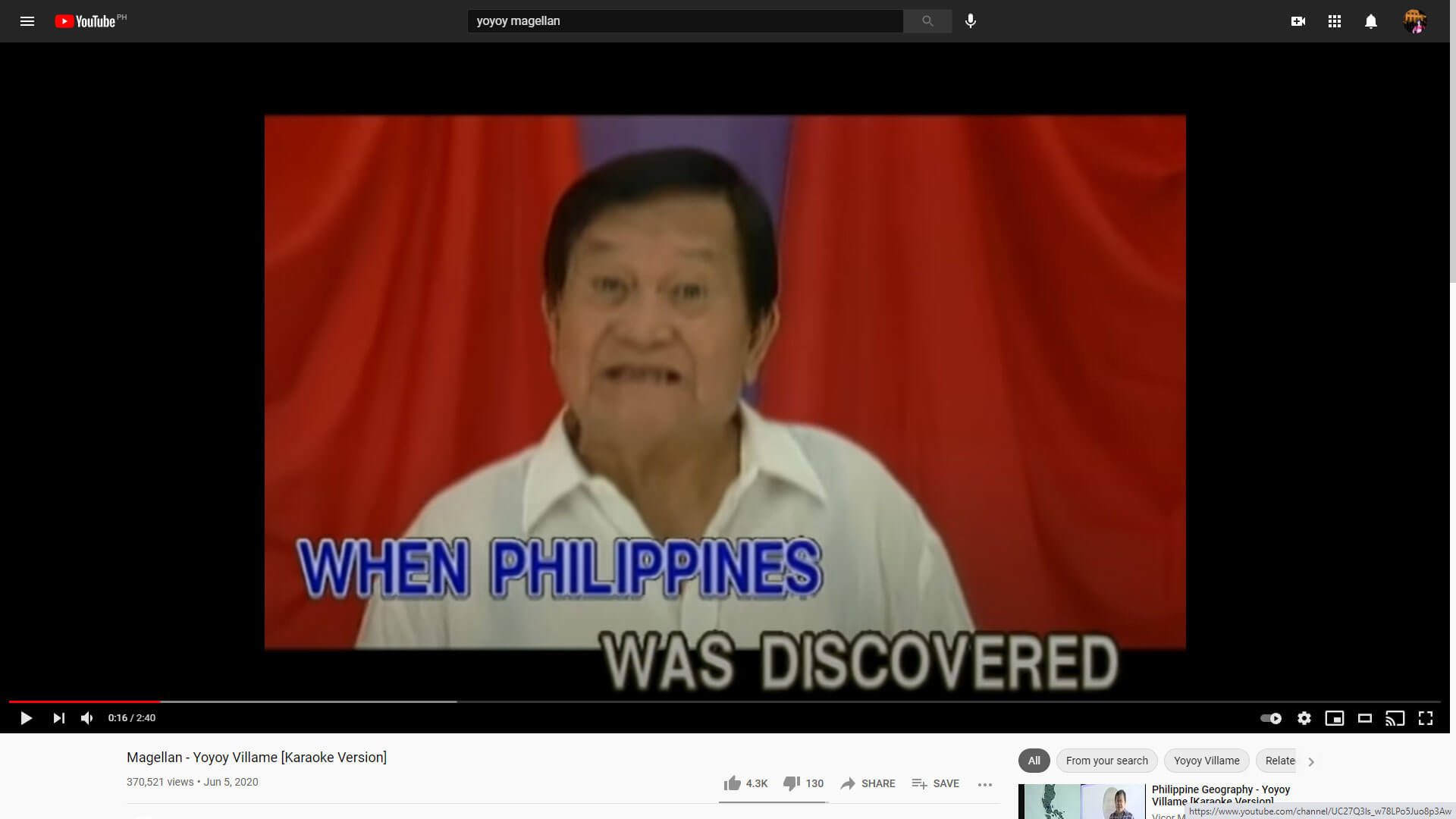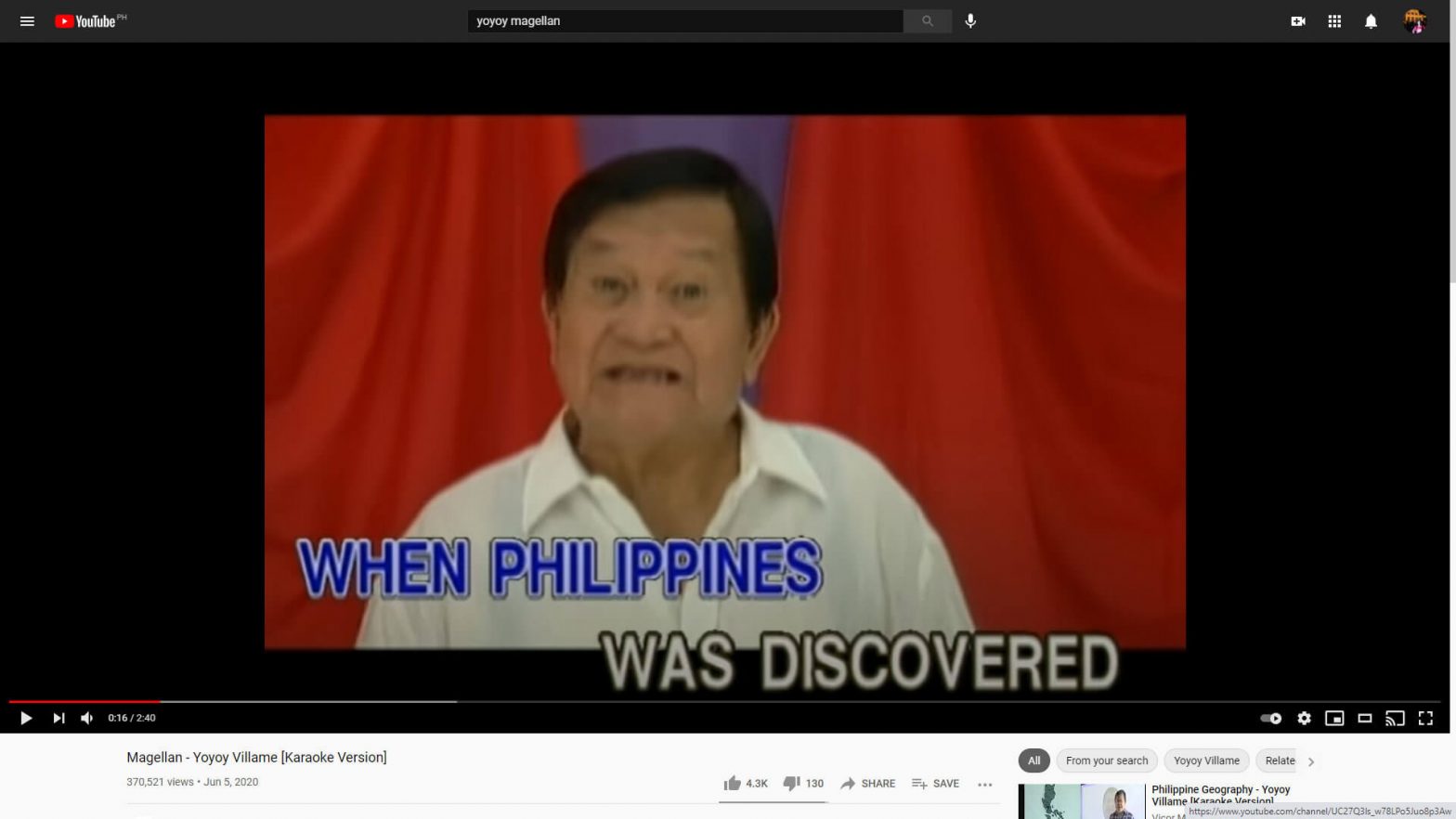Cebu has historians like Drs. Resil Mojares and Jobers Bersales as well as institutions like the Cebuano Studies Center and yet for the historic commemoration of the arrival of the Armada de Maluko, its news outlets turned to the eminent musician Yoyoy Villame. No, not just to reference his song, but for actual historical facts. Oh mother, mother I am sick.
One repeated the line that the Philippines was discovered by Magellan (imagine that!!! a local historian messaged me) while the other used his song to rewrite the actual timeline of the Spaniards in the Philippines. On the 500th year of their arrival in Suluan, the news outlet fast-forwarded to Limasawa (the Spaniards wouldn’t get there until March 28) because Yoyoy sang that they “landed in Limasawa at noon.” Oh mother, mother I am sick.
One outlet edited that mistake, the other decided to keep and continue the disinformation. It is disheartening to read the comments as some who tried to correct the disinformation were being asked “can you proved?”

That news outlet did not take any effort at all to correct that disinformation. It tells you about the attitude by some journalists toward truth, accuracy, and correcting errors no?
Like any Bisdak, I love Yoyoy’s “Magellan.” But it’s a song and it’s meant for fun. It does not claim to nor should it be treated as a historical narration of what happened. It also has, it turned out, an insidious influence especially on perpetuating that discovery narrative. So insidious it even influenced journalists today – a time when access to information is trivial.
It certainly made me reconsider my attitude toward that EZ Mil song where he said Lapulapu was beheaded in Mactan. I’ve always felt that we should just let it be, it’s just a song and people know that Lapulapu wasn’t actually beheaded. But judging from the impact of Yoyoy’s ditty, who’s to say people in the future (including journalists who would then use it as basis for reports) wouldn’t think that Lapulapu was actually beheaded.
The 500th year of the arrival of Spaniards provides a historic opportunity for local media to shine a light on our history and rethink narratives.
Until now, for example, there are still people who say that Magellan was here to “Christianize them everyone.” Magellan and the Armada de Molucca were looking for the Spice Islands not to evangelize or even conquer. When they fought Lapulapu and the Opon warriors, Magellan had a motley crew because the hardened warriors stayed away, Dr. Mojares said in a talk ignored by local media last year. These soldiers could not understand what they were still doing in Cebu when they should already be on their way to the Spice Islands.
There’s also the controversy on the “first recorded Easter mass.” For centuries, we’ve always thought it happened in Butuan. Conquistas de las Islas Filipinas 1565-1615 by Gaspar de San Agustin, for example, said the mass was held in Butuan. It was because of this early tradition that a monument to the “immortal Magellan” was built in Butuan.
It was changed to Limasawa in the 20th Century. During the 400th year commemoration of the Spaniards’ arrival, Limasawa was mentioned as site of the first mass. But proponents for Butuan never gave up and pressed their claim. The government has convened three panels these past decades to study the claim. All three panels ruled in favor of Limasawa. The last to do so was only last year, the Mojares panel.
You’d think the issue is settled, no? I did think it was and shelved an article I was planning to write. But no, some in the Butuan camp are still pressing that claim.
There’s also this: reference to this event is hyper-specific “the first recorded Easter mass” and not just the first mass, for a reason. The Spaniards held masses every day and likely held one when they reached Suluan or during the week they were in Homonhon. Pigafetta, an Eastern Visayas prelate told me, was a selective chronicler and likely did not mention about these earlier masses because these were commonplace, like having dinner or lunch. The Easter Mass, on the other hand, was chronicle-worthy because of the occasion and the presence of two local chieftains.
Our consolation despite this turn of events is that institutions like the National Quincentennial Committee, Cebuano Studies Center, Ramon Aboitiz Foundation Inc., and even brand like The Palm Grass Hotel are holding online events to talk about these important historical and cultural events. These events, except for those who paid for ad placements, are largely ignored by local media. If stories do come out, these are either press releases for upcoming talks or advertorials. The good thing, however, is that all these are online and can be replayed or watched at a later time if you miss them.
The celebrations in Cebu are still weeks away. Let’s cross our fingers we’ll read and see better-sourced and written posts by our favorite local news outlets.
Max is a journalist and blogger based in Cebu. He has written and edited for such publications as The Freeman, The Independent Post, Today, Sun.Star Cebu, Cebu Daily News, Philstar Life, and Rappler.
He is also a mobile app and web developer and co-founded InnoPub Media with his wife Marlen.


Leave a Reply